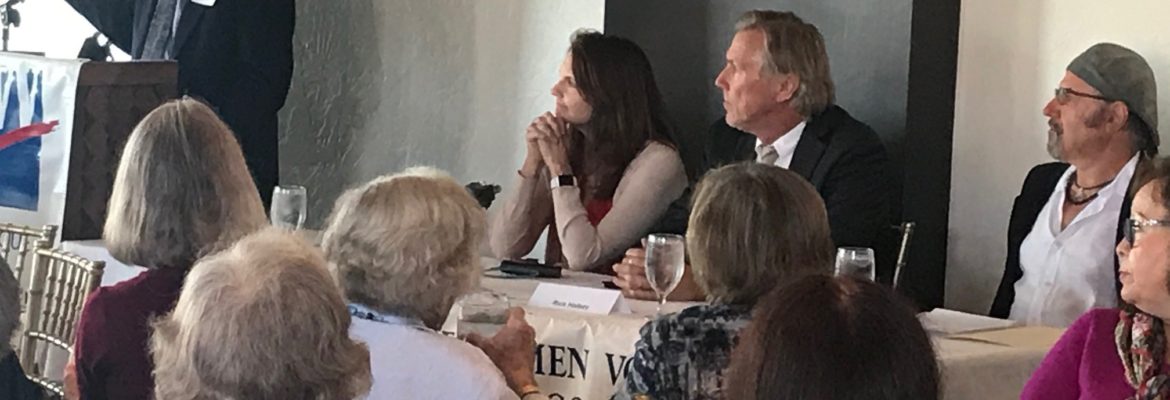The League of Women Voters of San Diego and Citizens Coordinate for Century 3 (C-3) teamed up on January 22 to host a luncheon entitled “Why Do We Need the Save Our San Diego Countryside (SOS) Initiative?” Both the League and C-3 are proponents of Measure A, also known as the SOS Initiative.
Measure A is a proposal on the March 2020 ballot that would require San Diego voters countywide to approve general plan amendments that significantly increase residential density in semi-rural and rural areas. As stated in its overview, [The County General Plan] “reflects the County’s commitment to a sustainable growth model that facilitates efficient development near infrastructure and services, while respecting sensitive natural resources….”
Participating on the panel were Nicole Capretz, Executive Director of the Climate Action Campaign; Rick Halsey, Director of the California Chaparral Institute; Lawrence Herzog, Ph.D., Professor Emeritus, Graduate Program in City Planning, SDSU School of Public Affairs and Visiting Scholar at UCSD; and moderator Phil Pryde, Ph.D., Professor Emeritus at SDSU, Past Chair of the San Diego County Planning Commission.
Pryde told the audience that when the County of San Diego general plan was updated in 2011, after 13 years of effort, it reaffirmed the previous plan that directed future growth to occur primarily where there was already growth and infrastructure. Since that time, the Supervisors’ approval of several projects that were inconsistent with the general plan and with the region’s climate goals, as well as growing wildfire danger, prompted organizers to craft and place Measure A on the ballot.
Addressing concerns raised by opponents of Measure A about San Diego’s housing crisis, Capretz encouraged the audience to address the crisis and land use patterns “holistically.” She added, “there is no way for our city, county, or state to reach climate goals if we continue with the sprawl patterns the County is proposing. The [climate] goals weren’t chosen randomly, they are based on the best available science.”
The Sierra Club and other environmental organizations have sued the County over its Climate Action Plan, which Capretz called a “fatally flawed plan based on carbon credits that can be purchased anywhere in the world.” The California Attorney General has weighed in on the side of the plaintiffs.
Herzog pointed out that large-scale rural and semi-rural development isn’t necessary to address San Diego’s housing crisis.
“The City of San Diego passed the City of Villages plan, creating centers where they exist already, and SANDAG created a smart growth strategy in its regional plan,” he said. “We need to go back to the idea of centrality. That’s the future.”
C-3 board member and co-organizer of the luncheon Susan Baldwin added, “Our 18 cities and the County have nearly 400,000 units of housing capacity in their combined general plans, the majority of which are multifamily and located near transit. The County General Plan allows 60,000 new homes to be built—most in the rural villages like Lakeside, Spring Valley, Valley Center and Fallbrook.”
Halsey reminded the audience that fire danger is another reason Measure A was proposed.
“Every single fire in this state was devastating,” he said. “All of them were wind driven and jumped fuel breaks….You cannot stop these fires, and can’t evacuate people out one road.”
Halsey explained that the government’s strategy of reducing fire danger in the backcountry by clearing chaparral actually has a detrimental effect on the ecosystem and to fire safety. Pryde concurred and pointed out that “wind goes right over oak trees,” resulting in the trees protecting structures around them during a wildfire.
Citing the path of destruction in San Diego’s Cedar and Witch Creek Fires, Pryde added, “Our fires burn east to west, so it’s not just a backcountry problem—the coasts are vulnerable too.”
When asked what citizens can do to pass Measure A, Pryde noted the grassroots nature of the campaign, “We are relying on people like you. We don’t have deep pockets.” Supporters of the Measure are using social media, digital advertising, the website and yard signs to communicate with voters.
About C-3
Since 1961, Citizens Coordinate for Century 3 (C-3) has sought and successfully advocated for the highest standards in urban design, community planning and access to public open space. As a member-supported, nonprofit organization, we bring together residents and professionals to jointly craft solutions to the challenges we face in our city and region. http://c3sandiego.org.
About The League of Women Voters of San Diego
The League of Women Voters, a nonpartisan political organization, encourages informed and active participation in government, works to increase understanding of major public policy issues, and influences public policy through education and advocacy.

